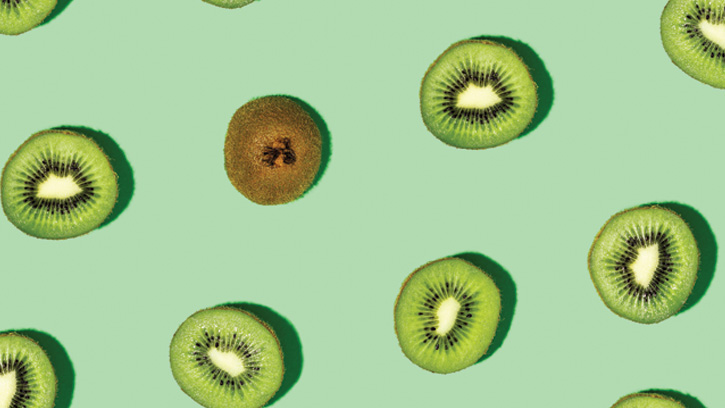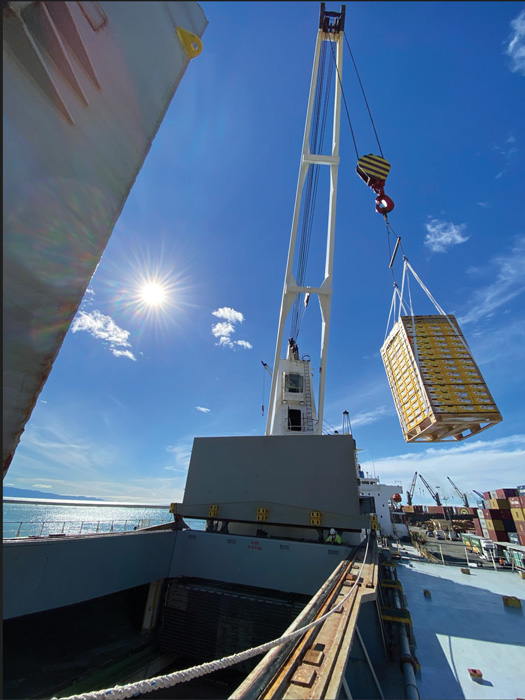Progressive Produce Packaging
Packaging | APPLIED SCIENCE
The goal of packaging science is to reduce food waste while maintaining safety. Most produce waste occurs after it has been fresh-processed and packaged, resulting in a loss of packaging value as well as product. Food waste in this category can be reduced with better labeling that links the value chain and advanced packaging. Labeling requirements and kiwifruit packaging provide excellent illustrations of the dynamics of progressive produce packaging.
A Need for More Consistent, Sustainable Labeling
Historically, produce safety has been focused on defining fresh processing record-keeping and traceability. Traceability has advanced beyond the on-package country of origin labeling mandated by European Union Regulation 178/2002, which required all foods to be traceable by 2005. The Food Safety Modernization Act (FSMA 204) in the United States will require supply chain record-keeping and more detailed labeling for high-risk produce by January 20, 2026. However, since FSMA 204 does not require consistency in the additional information required in labels, it falls short. For example, there are numerous labeling options in font, size, and location that can be used and required labels do not employ the “internet of packaging” that could enable enhanced value chain information.
While the added information on labels helps with traceability and identification at the point of sale, inventory management is a common issue for produce, which typically is sold individually and in high moisture produce environments. Apples, kiwis, avocados, and oranges, for example, are labeled individually, whereas greens are labeled on the bag. These individual labels are problematic because they prevent produce that is unfit for human consumption due to blemishes, cuts, and scratches from being upcycled, blended, and processed into juice, sauces, dried seasonings, and compost.
Removal of these individual labels is difficult and time-consuming because it frequently leaves residue. As a result, regulations requiring food-grade compostable labels (Canada) or label removal (New Zealand) have been enacted. Compostable labels are required to maintain produce weight and to prevent waste of extended shelf life produce such as apples. However, when compostable labels are exposed to high-humidity environments, they frequently become illegible. Label removal solves the problem, but it hinders traceability and retailer tracking. Labeling produce in the second stage of retailer evaluation and regrading produce prior to sale, as well as advances in printing technologies enabling higher resolution printing and faster dry times when printing on packages and high-moisture produce, could be the answer.
Kiwis Demand Unique Packaging
New Zealand’s fertile soil and combination of sunshine and rain allow for a 160-day kiwifruit growing season, with harvest taking place from March to June. As a result, New Zealand’s $3 billion kiwi industry has one of the world’s most extended supply chains, requiring a 5- to 8-month shelf life. This means that primary, secondary, and tertiary packaging needs to be highly refined to reduce losses while maintaining quality and safety. The long harvest season and distribution range of kiwis from New Zealand present unique challenges with solutions that can be applied to other produce packaging.
Ventilated corrugated boxes dominate kiwi tertiary packaging. These aid in the initial rapid cooling of pallet loads of kiwi and in maintaining the controlled temperatures required for adequate shelf life. Although packaging varies by country, the standard kiwi tray is designed to withstand pallet stacking and extensive storage for 5–8 months. The most common rectangular tray pack is a double wall C and E flute on the width dimension that is overlapped and glued on each corner to form an internal triple wall corner post. Tabs that extend across the width of the two-part folded cover lock into the base of the next stacked tray. This results in a very stable pallet load.
Venting is made easier by cutouts that align with pallet patterns. To facilitate potential fumigation or unwrapping and regrading/sorting by distributors and retailers, kiwis either are individually cradled in thermoformed polyethylene trays or are packed in bulk and then loosely wrapped in high-density polyethylene (HDPE) film within the corrugated boxes. Computational fluid dynamics (CFD) and optimization of dimensional weight (DIM), which is the amount of space a package occupies versus the actual weight, have been used to define the packaging format. In the case of kiwi, the void spaces between bulk-packaged kiwi and thermoformed trays require more space per pound than other fruits that can be more densely packed.
Kiwi Research Down Under
The Massey University research team in Palmerston North, New Zealand, optimizes packaging to achieve more sustainable packaging while reducing fruit losses and costs across the entire delivery system. John Bronlund, professor of food and bioprocess engineering at Massey University’s School of Food and Advanced Technology, elaborates on his research group’s work on DIMs and CFD. “We created a synthetic kiwi to broaden our analysis time window and provide research direction. First, we used predictive modeling to refine packaging during the off-season, and model cooling rates and packaging strength as a function of case dimensions, venting, and pack density,” Bronlund explains.
“Then we used the synthetic kiwi to measure pack performance in a full-scale laboratory precooler,” he notes. “We have spent a lot of time investing in developing and validating simplified models, using this two-stage process, allowing for the use of models in optimization algorithms.”
Kiwi, as a climacteric fruit, is extremely sensitive to ethylene, with as little as 10 ppb causing softening and reducing shelf life (Jabbar and East 2016). Ethylene can be deliberately used to promote the ripening of kiwi. However, when trying to store for extended periods, ethylene within the package promotes undesirable ripening of the entire kiwi, reducing the fruit’s storage life.
Andrew East, professor of postharvest engineering at Massey University, and his research group continue to make strides in extending the shelf life of kiwi using packaging. In one study, the group tested modified atmospheres of 12%–15% O2, 3%–4% CO2 within non-perforated films and found that the combination reduced kiwifruit softening. “The results showed that MAP can extend the shelf life of kiwis,” East says.
East also notes that other packaging research published by scientists from the university’s Massey AgriFood Digital Lab shows similar findings. While an ethylene scrubber can frequently reduce ethylene, new research has shown that ethylene production by an inadvertently damaged kiwi may exceed that which can be absorbed by the scrubber and therefore, can result in food loss and waste (Han et al. 2022). At the same time, the study found that MAP or perforated film (air) packaging under several cold storage conditions resulted in reduced kiwifruit softening up to a 45-day shelf life. According to another Massey study, utilizing state-of-the-art grading technologies such as image processing and near-infrared spectroscopy (NIR) enables the segregation of kiwi by maturity level and size grade, preventing damaged fruit from ending up in the package in the first place (Li et al. 2002). “This grading is estimated to reduce the incidence of unacceptably soft kiwi by 30%,” East concludes.
Given that the majority of New Zealand kiwi is destined for the export market, kiwi packaging must adapt to a greater number of produce packaging regulations while remaining consistent with New Zealand’s sustainability expectations. Plastic packaging for kiwi, for example, has been banned in France. However, removing the plastic overwrap will reduce kiwi shelf-life due to water loss and the associated development of unsightly shrivel. The total environmental cost of growing, packaging, processing, and transporting food and the environmental costs of sourcing and disposing of packaging are critical to achieving a more sustainable food system.
Models created for kiwi with diverse packaging requirements can be applied to these complex systems. Research is in the works to make kiwi packaging “future-proof” and to create the most sustainable export packaging. For example, data from the Massey team show a “hockey stick” relationship between the environmental impact (in carbon dioxide equivalents, kg CO2-eq) and package performance.
“We are determining the life cycle impact from farm to fork using GaBi software to capture the environmental impact of packaging and kiwi waste in the value chain,” Eli Gray-Stuart, senior lecturer at Massey University, adds. “Our LCI modeling will guide how to package kiwi for each different end market best to meet the unique regulatory requirements, overseas disposal options, and packaging sourcing from within or close to New Zealand. This aligns with New Zealand’s clean and green expectations and will help ensure that our kiwi export packaging is the most sustainable it can be.”
Learning Objectives
- Define the role of packaging for produce in the context of FSMA 204.
- Learn from an example of the complexity of kiwi packaging to construct guardrails for other types of produce.
- Appraise primary, secondary, and tertiary packaging for its role in protecting produce.




